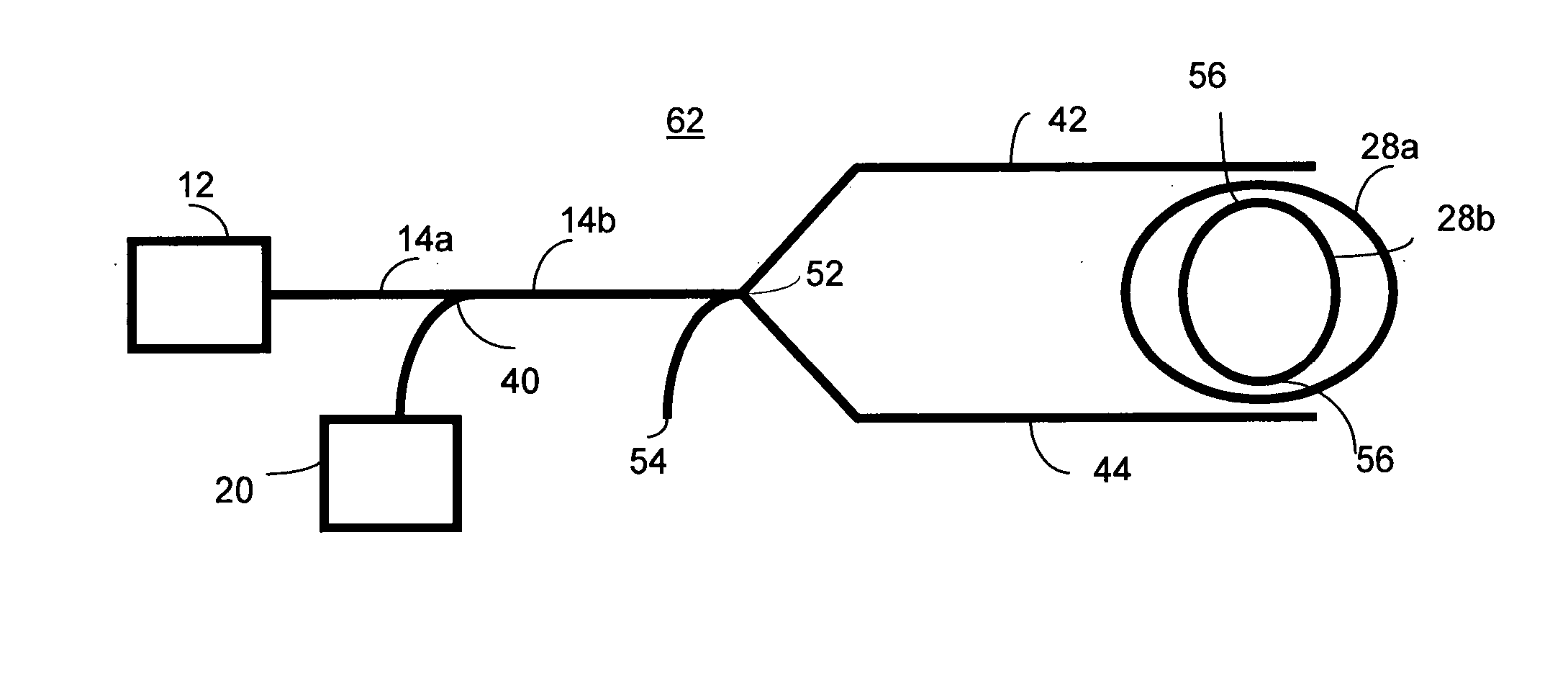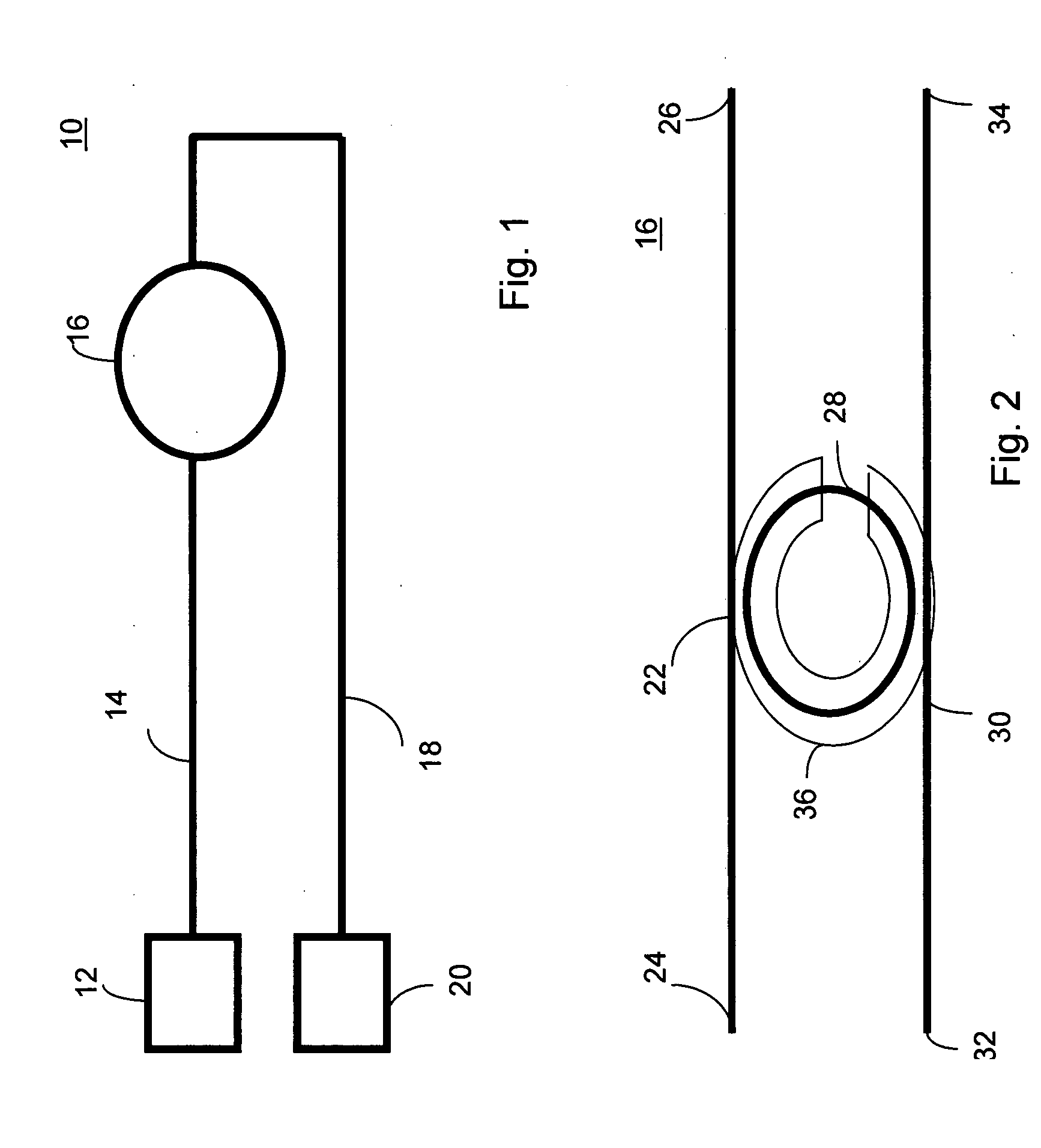Micro-resonator based optical sensor
a micro-resonator and optical sensor technology, applied in the field of electro-electro-radiation detectors, can solve the problems of limited sensitivity of such sensors, difficult to achieve, lack of sensitivity of devices, etc., and achieve the effect of maximizing the sensitivity of the sensing elemen
- Summary
- Abstract
- Description
- Claims
- Application Information
AI Technical Summary
Benefits of technology
Problems solved by technology
Method used
Image
Examples
first embodiment
[0059]FIG. 3a illustrates a high level block diagram of an improved sensing element 16′ exhibiting enhanced sensitivity as compared with sensing element 16 of FIG. 2. Improved sensing element 16′ is operable to replace sensing element 16 of FIG. 1 and to be operable as part of sensing system 10. Sensing element 16′ comprises first optical waveguide 22 having input 24 and output 26, first sensing resonator cavity loop 28a, second sensing resonator cavity loop 28b, optional first and second tuning elements 36, and second optical waveguide 30 having input 34 and output 32. First optical waveguide 22 is placed in close proximity to at least a portion of first sensing resonator cavity loop 28a thus creating a first interaction area of evanescent coupling. At least a portion of second sensing resonator cavity loop 28b is placed in close proximity to at least a portion of first sensing resonator cavity loop 28a thus creating a second interaction area of evanescent coupling. Second waveguid...
second embodiment
[0065]FIG. 3b illustrates a high level block diagram of an improved sensing element 16′ exhibiting enhanced sensitivity. Improved sensing element 16′ is operable to replace sensing element 16 of FIG. 1 and to be operable as part of sensing system 10. Sensing element 16′ comprises input optical waveguide 14, reference resonator cavity loops 28e, 28f, optional first and second tuning elements 36, first optical waveguide 22 having output 26, first sensing resonator cavity loop 28a, second sensing resonator cavity loop 28b, optional third and fourth tuning elements 36, and second optical waveguide 30 having output 32. Input optical waveguide 14 is placed in close proximity to at least a portion of first reference resonator cavity loop 28e thus creating a first interaction area of evanescent coupling. First reference resonator cavity loop 28e is placed in close proximity to at least a portion of second reference resonator cavity loop 28f, thus creating a second interaction area of evanes...
third embodiment
[0069]FIG. 3c illustrates a high level block diagram of an improved sensing element 16′ exhibiting enhanced sensitivity. Improved sensing element 16′ is operable to replace sensing element 16 of FIG. 1 and to be operable as part of sensing system 10. Sensing element 16′ comprises input optical waveguide 14, reference resonator cavity loop 28e, first tuning element 36, first optical waveguide 22 having output 26, sensing resonator cavity loop 28a, optional second tuning element 36, and second optical waveguide 30 having output 32. Input optical waveguide 14 is placed in close proximity to at least a portion of reference resonator cavity loop 28e thus creating a first interaction area of evanescent coupling. First reference resonator cavity loop 28e is placed in close proximity to at least a portion of first optical waveguide 22 thus creating a second interaction area of evanescent coupling. First tuning element 36 is placed in proximity to reference resonator cavity loop 28e so as to...
PUM
 Login to View More
Login to View More Abstract
Description
Claims
Application Information
 Login to View More
Login to View More - R&D
- Intellectual Property
- Life Sciences
- Materials
- Tech Scout
- Unparalleled Data Quality
- Higher Quality Content
- 60% Fewer Hallucinations
Browse by: Latest US Patents, China's latest patents, Technical Efficacy Thesaurus, Application Domain, Technology Topic, Popular Technical Reports.
© 2025 PatSnap. All rights reserved.Legal|Privacy policy|Modern Slavery Act Transparency Statement|Sitemap|About US| Contact US: help@patsnap.com



